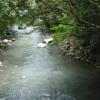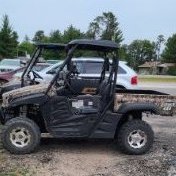By
Emilios garage
Just bought a new Sector 750. It's slightly better looking and equipped than the Axis 700 models they sell at Lowes or the RK and other versions but there's very little difference in the frame and drive train. Seems to be a good machine to use around the farm and riding around the neighborhood. If you own any of these Hisun made machines, you may have similar issues. After driving this around on some country roads doing some break in riding, an extraordinary amount of radiant heat was emitting out from behind the seat and under the dump bed. The engine temp was showing normal on the gauge. The source of the extreme heat was mainly the muffler, and it was even hot enough to soften the plastic underside of the dump bed. You could smell the plastic was almost at that melting temp. I've never seen anything like this on any brand of machine. This could possibly qualify for a safety recall. Back at the shop afterwards to study the situation revealed some suspected bad exhaust designs to be the main cause. The pipe going into the muffler from the engine is 1 3/4 inch in size. The pipe coming out of the muffler is 3/4 inch. A one inch difference! That's a lot of very hot gases going in through a large opening, compressing inside the chambers of that muffler, and trying to get out through a much smaller hole. Simple science will tell you that even cool air when compressed gets hot. Science has also shown that hot air flows faster than cool air. This muffler by design is causing already hot gasses emitted from the engine to be accumulating, compressing and therefore amplifying that temperature to far greater temps than what the engine itself was emitting. I'm sure all that back pressure is also causing the engine to labor some too and wasting HP. The same muffler appears to be used on the 550, 700, or 750 Hisun variants. The exhaust tip on the back of the muffler is removable and when you do there will be even more engineering issues revealed. The 3/4 inch pipe extends inside the rear chamber of the muffler about 3 inches. There is a metal case over and around the internal 3/4 inch pipe section with a steel screen around that. If the 3/4 inch outlet wasn't bad enough, that case and screen cause even more restriction and back pressure compression. Those of us who turn wrenches already know that screen is only in there because of certain mandated requirements, but now we're talking about outflow that would be around the equivalent to a 1/2 inch outlet with all this. The first attempt to reduce the extreme exhaust temps was done by just removing the screen and cage from the internal section of the exhaust tip. The 3/4 inch tip was reinstalled as just the pipe and the machine test driven again. No longer had quite the extreme scorching heat but still felt like the exhaust temp was still too high. I did notice that the radiant heat from the lower exhaust pipe section which is about 4 inches from the drive shaft was enough to melt and burn the rubber boot that covers the shaft yoke just behind the u-joint. Don't know yet if the rubber parts of the u-joint were compromised. The next attempt to mitigate this problem was to manufacture a new exhaust tip with greater outflow. One that would have the same size pipe on the outflow side to relieve this engine of back pressure and fix the heat problem. My car, my riding lawnmower and other brand UTVs have mufflers designed this way, why not this Hisun machine? I could not find any aftermarket companies that already make this part, so now I do. If you are handy with a mig welder, a drill and some hole saws, then you can make this part too for around $20 worth of materials. (Bi-metal hole saws not included) It's up to you what angle you want coming out of the tip. I went with 90 degrees and a slight downward angle, but 45 degrees will work too. The exhaust outlet is now also a 1 3/4 inch pipe. This seems to have fully solved the extreme exhaust heat problem. The engine idles smoother now, and I do not notice any louder exhaust noise than what I had before. In fact, it's actually quieter now because the high-pressure air release noise the original tip made is gone. The issue of the lower pipe heat next to the drive shaft is still being evaluated. Possible fixes for that if still needed would be a shield wrap on that section of the exhaust pipe or a clamp-on aluminum shield. People, this is an engineering issue, no warranty can fix this. Attached are some pictures I took during this project. Good luck with your Hisun machines.
Safe trails, E






Recommended Posts
Join the conversation
You can post now and register later. If you have an account, sign in now to post with your account.
Note: Your post will require moderator approval before it will be visible.